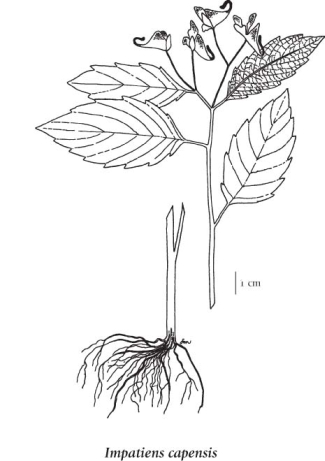spotted touch-me-not (jewelweed; orange balsam; spotted jewelweed)
Balsaminaceae (Touch-me-not family)
Introduction to Vascular Plants
Introduction click to expand contents
Jewelweed is a native flowering annual that is found in lightly shaded moist to wet areas, including wet woods, floodplains, swamps, seeps, fens, lake edges and ditches (Hilty 2012). The spotted orange spurred flowers are present in the summer through to early fall. It is pollinated by insects and hummingbirds (Pojar 2012).
|
Species Information click to expand contents
General:
Annual succulent herb; stems erect to ascending, often branched, glabrous, 20-80 cm tall.
Leaves:
Alternate, stalked, egg-shaped to elliptic, shallowly and remotely saw-toothed, 3-12 cm long.
Flowers:
One to several in leaf axils, orange with mottled reddish-brown spots; sepals pouched, with spur curved or hooked.
Fruits:
Capsules, elastically dehiscent, 10-20 mm long, many-seeded.
Illustration click to expand contents

If more than one illustration is available for a species (e.g., separate illustrations were provided for two subspecies) then links to the separate images will be provided below. Note that individual subspecies or varietal illustrations are not always available.
Illustration Source: The Illustrated Flora of British Columbia
USDA Species Characteristics click to expand contents
Flower Colour:
Yellow
Blooming Period:
Indeterminate
Fruit/Seed characteristics:
Colour: Brown
Present from Summer to Fall
Source: The USDA
Ecology click to expand contents
The table below shows the species-specific information calculated from
original data (BEC database) provided by the BC Ministry of Forests and Range.
(Updated August, 2013)
| Site Information |
Value / Class |
||
|
Avg |
Min |
Max |
|
| Elevation
(metres) |
|||
| Slope
Gradient (%) |
|||
|
Aspect (degrees) |
0 | ||
| Soil
Moisture Regime (SMR) [0 - very xeric; 4 - mesic; 8 - hydric] |
5 | 5 | 5 |
| Modal
Nutrient Regime
Class |
C | ||
| #
of field plots species was recorded in: |
2 | ||
| Modal
BEC Zone Class |
CWH | ||
|
All BEC Zones (# of stations/zone) species was recorded in |
CWH(2) | ||
|
Source:
Klinkenberg 2013
|
|||
Habitat and Range click to expand contents
Status Information click to expand contents
Synonyms click to expand contents
Synonyms and Alternate Names:
Impatiens biflora Walter
Impatiens fulva Nutt.
Impatiens noli-tangere subsp. biflora (Walter) HultΘn
Impatiens nortonii Rydb.
Taxonomic Keys click to expand contents
Taxonomic Key to Impatiens
1. Pouched sepals not spurred......................................I. ecalcarata 1. Pouched sepals spurred. 2. Leaves opposite or whorled (at least some of them), finely saw-toothed; flowers blue to purple or purplish-pink or sometimes white............................ I. glandulifera 2. Leaves alternate, coarsely saw-toothed; flowers orange or yellowish. 3. Spurs of the sepals straight, directed backward.......................................I. parviflora 3. Spurs of the sepals curved or hooked. 4. Flowers less than 2 cm long, without spots..........................I. aurella 4. Flowers more than 2 cm long, spotted, mottled or sparingly flecked. 5. Flowers orange, brown-spotted, or -mottled.........................I. capensis 5. Flowers yellow, sparingly flecked with brownish purple........................I. noli-tangere |
Taxonomic Notes click to expand contents
Because it was not collected in our region until 1950, Impatiens capensis may be introduced in the Pacific Northwest according to Peter Zika. Read his article in the Journal of the Torrey Botanical Society, listed below.
Note Author: R. Klinkenberg, August 3, 2009. Further Reading: Ornduff, R. 1966. Impatiens capensis in Oregon: native or naturalized? Leaflets of Western Botany 10: 317-319. Zika, Peter. 2006. The Status of Impatiens capensis (Balsaminaceae) on the Pacific Northwest Coast. Journal of the Torrey Botanical Society 133(4): 593-600. Zika, Peter. 2009. Impatiens of the Pacific Northwest. Available: http://bomi.ou.edu/ben/408/impatiens_figures_408.pdf. Accessed August 3, 2009. Taxonomic Key to Impatiens 1. Pouched sepals not spurred......................................I. ecalcarata 1. Pouched sepals spurred. 2. Leaves opposite or whorled (at least some of them, finely saw-toothed; flowers blue to purple or purplish-pink or sometimes white............................ I. glandulifera 2. Leaves alternate, coarsely saw-toothed; flowers orange or yellowish. 3. Spurs of the sepals straight, directed backward.......................................I. parviflora 3. Spurs of the sepals curved or hooked. 4. Flowers less than 2 cm long, without spots..........................I. aurella 4. Flowers more htan 2 cm long, spotted, mottled or sparingly flecked. 5. Flowers orange, brown-spotted, or -mottled.........................I. capensis 5. Flowers yellow, sparingly flecked with brownish purple........................I. noli-tangere |